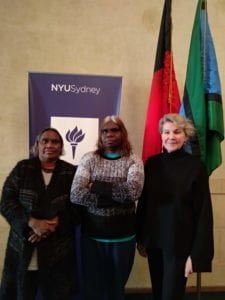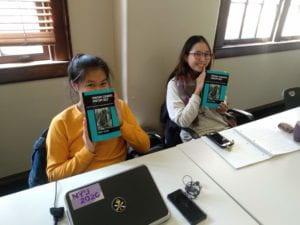The Warmth of a Walpiri Welcome
By Petronella Vaarzon-Morel, NYU Sydney Anthropology Lecturer
 This September, students in the Anthropology of Indigenous Art and Anthropology classes were privileged to meet with Warlpiri cultural experts Selina Williams Napanangka and Julie Kitson Napaljarri from Willowra, an Indigenous community which is located 350 kilometres north-west of
This September, students in the Anthropology of Indigenous Art and Anthropology classes were privileged to meet with Warlpiri cultural experts Selina Williams Napanangka and Julie Kitson Napaljarri from Willowra, an Indigenous community which is located 350 kilometres north-west of
Alice Springs in Central Australia.
NYU Sydney was recently honoured to host Warlpiri cultural experts Selina Williams Napanangka and Julie Kitson Napaljarri from Willowra. Selina and Julie were guests for two classes within a week on campus. The occasions brilliantly illustrated the opportunities afforded by the anthropology classes and the Sydney campus for meaningful cross- cultural exchanges between Indigenous Australians and NYU students.
Julie and Selina are both skilled artists and performers of the Warlpiri women’s yawalyu ceremonies, which celebrate their ancestral connections to country through song, dance, and body painting.
Both women are currently involved in two collaborative projects with NYU anthropology lecturer Petronella Vaarzon-Morel. The first is a cultural mapping project which involves traditional owners visiting their ancestral countries in the Lander Warlpiri Anmatyerr region and mapping ancestral tracks, sites and cultural heritage information. The second is a cultural returns project, an Australian Research Council Linkage project involving the Indigenous body the Central Land Council, and researchers from The University of Sydney and The University of Melbourne. The project has been running for three years and is near completion.
During this period the researchers have located large collections of Central Australian Indigenous cultural materials which are held in diverse public and private collections. Applying international best practice, material (primarily images and audio-visual ) has been digitised and reconnected with rightful Indigenous people.
The project has helped preserve Indigenous heritage, improve community access, safeguard at-risk materials, support intergenerational knowledge transfer, and provide a framework for the development of a repatriation policy. At the time of their visit to NYU Sydney, Julie and Selina were visiting archives in Sydney and Canberra for the project.
The theme of the Indigenous Art class for the week was Warlpiri and Anmayerr art. In addition to providing insights into the different Warlpiri modes of artistic practice, and providing feedback on the readings for the week, Julie and Selina taught students the basics of the Warlpiri traditional iconographic system. The iconography is employed in body painting, sand drawing and the contemporary Western Desert style of acrylic painting on canvas which has become renowned throughout the world.
In a fascinating cross-cultural exercise, students later viewed video clips made by Petronella of Julie and Selina providing their interpretations of works such as Jackson Pollock’s Blue Poles in the American Masters Exhibition, which was on display next to the Indigenous Gallery.
Following their visit to Sydney, Julie and Selina visited the National Gallery in Canberra, where they expressed great pride in seeing Aboriginal art in the nation’s capital. Julie commented “it’s so amazing to see Aboriginal art displayed so beautifully here. The last time I came with you [Petronella] to Canberra in the late 1970s we hardly saw any Aboriginal art. It’s good to see the increased recognition of Aboriginal people in Australia.”
Julie and Selina joined students of the Anthropology class to view the virtual reality film Collisions, directed by Lynette Wallworth with Indigenous elder Nyarri Nyarri Morgan. The film, recounts Nyarri Nyarri Morgan’s recollections of his first contact with Europeans during the 1950s, and the fallout of the atomic bomb over his people, the Martu in the region known as the Pilbara in Western Australia. The viewing provided a great opportunity for the Warlpiri guest speakers to share their reflections on the violent history of settler colonisation of Australia and Indigenous responses. This in turn prompted exchanges. For example, one student spoke of the feelings the film stirred concerning the bombing of Japan, her homeland during the 2nd World War.
 Julie told the students about the murder of her relatives during the Coniston Massacre, which took place in the Willowra region in 1928. Coniston is officially recognised as the last massacre of Aboriginal people in Australia. The students also heard excerpts from radio interviews with Aboriginal people including Julie’s son Dwayne Ross, sister Maisie Napaljarri, and also Petronella about the Massacre. The interviews were recorded during the recent Coniston Massacre memorial day, which was held at Yurrkuru, the place where the massacre began.
Julie told the students about the murder of her relatives during the Coniston Massacre, which took place in the Willowra region in 1928. Coniston is officially recognised as the last massacre of Aboriginal people in Australia. The students also heard excerpts from radio interviews with Aboriginal people including Julie’s son Dwayne Ross, sister Maisie Napaljarri, and also Petronella about the Massacre. The interviews were recorded during the recent Coniston Massacre memorial day, which was held at Yurrkuru, the place where the massacre began.
During this commemorative event Warlpiri spokespeople called for a National Remembrance Day to remember the victims of massacres of Indigenous people that have occurred throughout Australia. The exchange between the NYU students and Julie and Selina were respectful and relaxed, and they highlighted the importance of the recognition of Indigenous Australians, of the true history of Australia, and of reconciliation.
During the Anthropology class Selina and Julie instructed the students in Warlpiri kinship and classificatory or “skin” system. Each student received a skin name and had to work out how they were related to Julie and Selina. In learning about their kinship relationships, they also learnt about appropriate marriage partners and kinds of behaviors associated with different kinspersons. In illustrating the importance of the relational ontology which is foundational to Warlpiri society, the exercise facilitated understanding of different ways of being in the world. Selina later commented to Petronella, “the students were pretty quick in learning their skin names. They feel proud of them. They will have them forever and will take them back to their country and share the names and their experiences. If they want to come to central Australia, we would welcome them.”
Both students and Julie and Selina felt that there wasn’t enough time to share all they could and hoped that there will more opportunities for cross-cultural exchanges at NYU Sydney in the future.